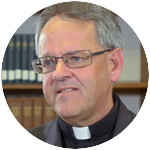
Father Thomas Dailey, O.S.F.S.
“Back to school” just doesn’t have the same ring to it this year. Going “back” involves no change of place if schools are only offering online learning. Going “to” need not refer to a school building but only an access center. And how will “school” paralyzed by a pandemic function? At least those who go back to work there this year can get some free coffee!
The return to the ABC’s and the three R’s this week also marks a return to religious education. That work faces a challenge greater than dealing with a coronavirus. Catechesis will crumble if it fails to adapt to the digital environment in which we live and learn.
The Vatican’s new “Directory for Catechesis,” published this summer, recognizes this in a new analysis of religious education in a digital culture (nn. 359-372). There we find four factors calling for attention if we are to succeed at sharing the faith with present and future generations.
[hotblock]
The first is the realization, not yet commonly shared among church leaders, that “the digital … is not only part of the existing cultures, but is asserting itself as a new culture.” As its own culture, it exercises a profound effect on how people live – and, consequently, on how we teach and learn – by “changing language, shaping mentalities, and restructuring value hierarchies.” This transformation has been so influential that it appears quite natural.
There’s no denying or ignoring it. Digital communications in parish life, and in the catechesis that shapes its future, can no longer be considered merely a technological tool or a pedagogical plaything. Intentional investment, in terms of material and human resources, is needed to save our religious education from falling into irrelevance and insignificance in this new ecology.
That may sound melodramatic. But before dismissing the demand, consider two further principles in the Directory that focus on how people think and believe in a digital world.
On the one hand, life has become data-driven, governed by “ever more sophisticated algorithms and software.” Even, or especially, in this environment, people continue to think about the big questions of life. But where do they turn for answers?
[tower]
In earlier days it may have been to parents or pastors or teachers. But in a digital world, devices have displaced traditional sources of trust and authority. Google now has all the godly answers, which its search engines generate in mere seconds, and bloggers hold sway over belief, with people in the pews becoming more and more divided in their religious allegiances.
On the other hand, stories of faith have not lost their appeal. As the Directory puts it, “the language that has the greatest hold on the digital generation is that of the story, rather than that of argumentation.” Granted, people still need to learn how to decipher what is believable amidst the morass of information proffered in and by the media. But “the art of storytelling … is considered by the young as more convincing and compelling than the traditional forms of discourse.”
Consequently, catechesis that commands assent, or learning by way of memorization, will no longer persuade the digital generation. Fortunately, religious educators have a preeminent source at their disposal – the “story of stories” that is Sacred Scripture, along with the lives of saints who embody that story. In and through these sacred tales, as Pope Francis reminds us, “life becomes history.”
Stories told and lived shape our identities. Stories preached and practiced will form the faith in future generations, especially among digital natives who, sadly, see few public models of meaning elsewhere.
Catechesis can be enhanced exponentially by the audio and video capabilities of today’s technologies. From Netflix to networks, from YouTube to user-generated content, the digital environment thrives on the interactivity that helps to form the human and the church community.
But, as its final principle, the Directory rightly concludes that “in the process of proclaiming the Gospel, the real question is not how to use the new technologies to evangelize, but how to become an evangelizing presence on the digital continent.” Becoming that presence is our shared task as believers.
That presence may be different online, but it is no less personal if we realize that even via social media, a human encounter still takes place between people seeking the truth in love.
For parish catechesis, that search now warrants a greater investment in digital communications, so that the power of being present to each other in the faith can make going “back to school” the meaningful adventure it has always been.
* * *
Father Thomas Dailey, O.S.F.S. is the John Cardinal Foley Chair of Homiletics and Social Communications at St. Charles Borromeo Seminary, Wynnewood, and a research fellow for the Catholic Leadership Institute in Wayne.
PREVIOUS: Can we disagree less disagreeably?
NEXT: To walk in our divided political land, try buddy system



Share this story